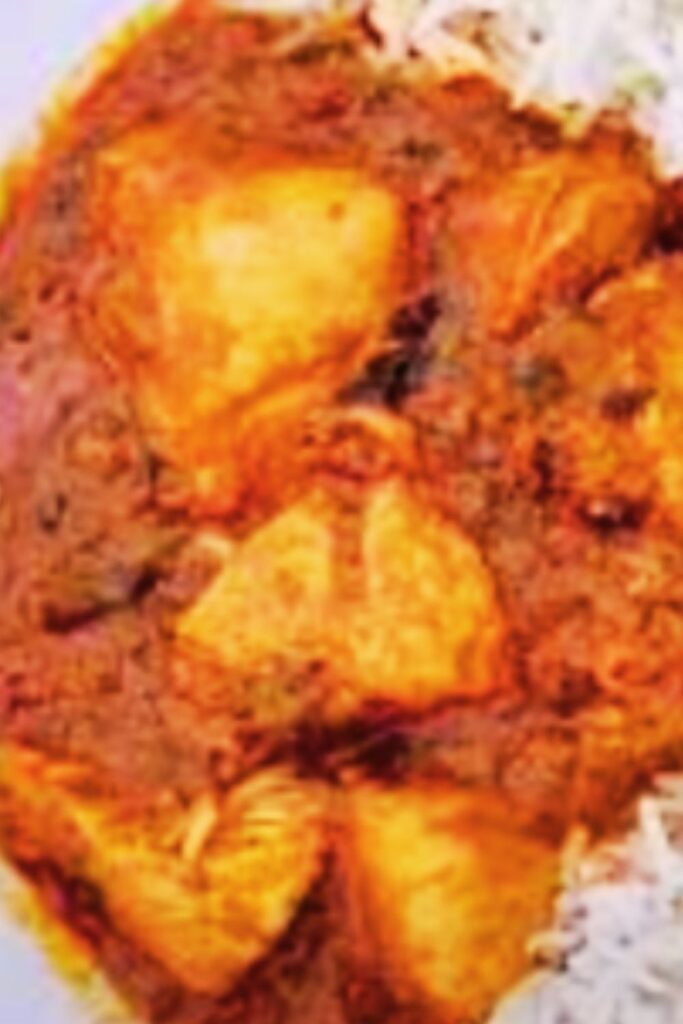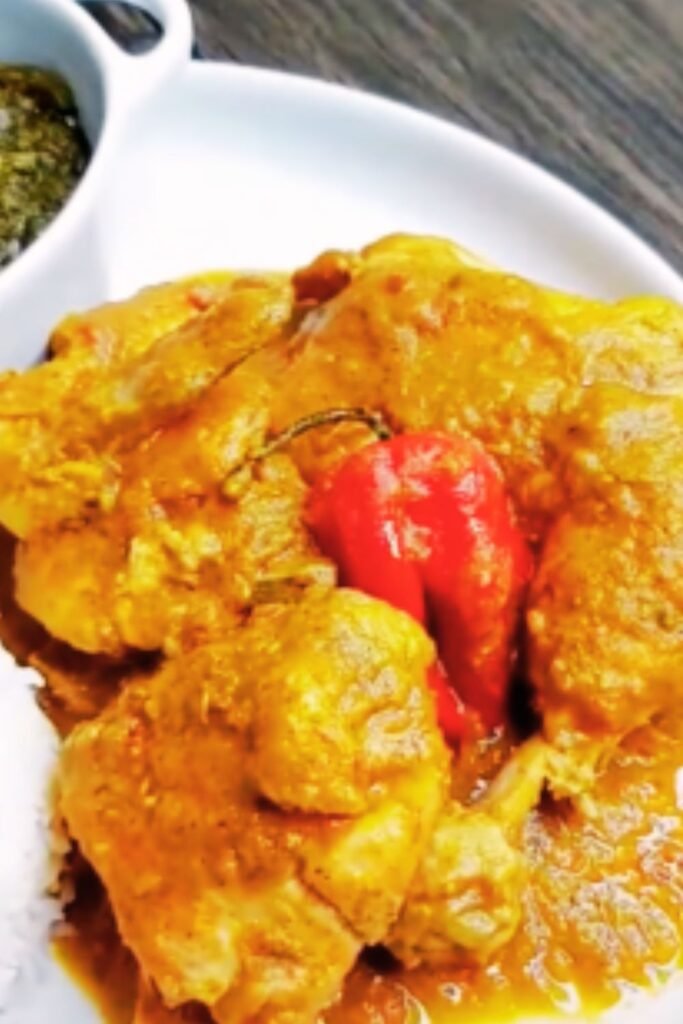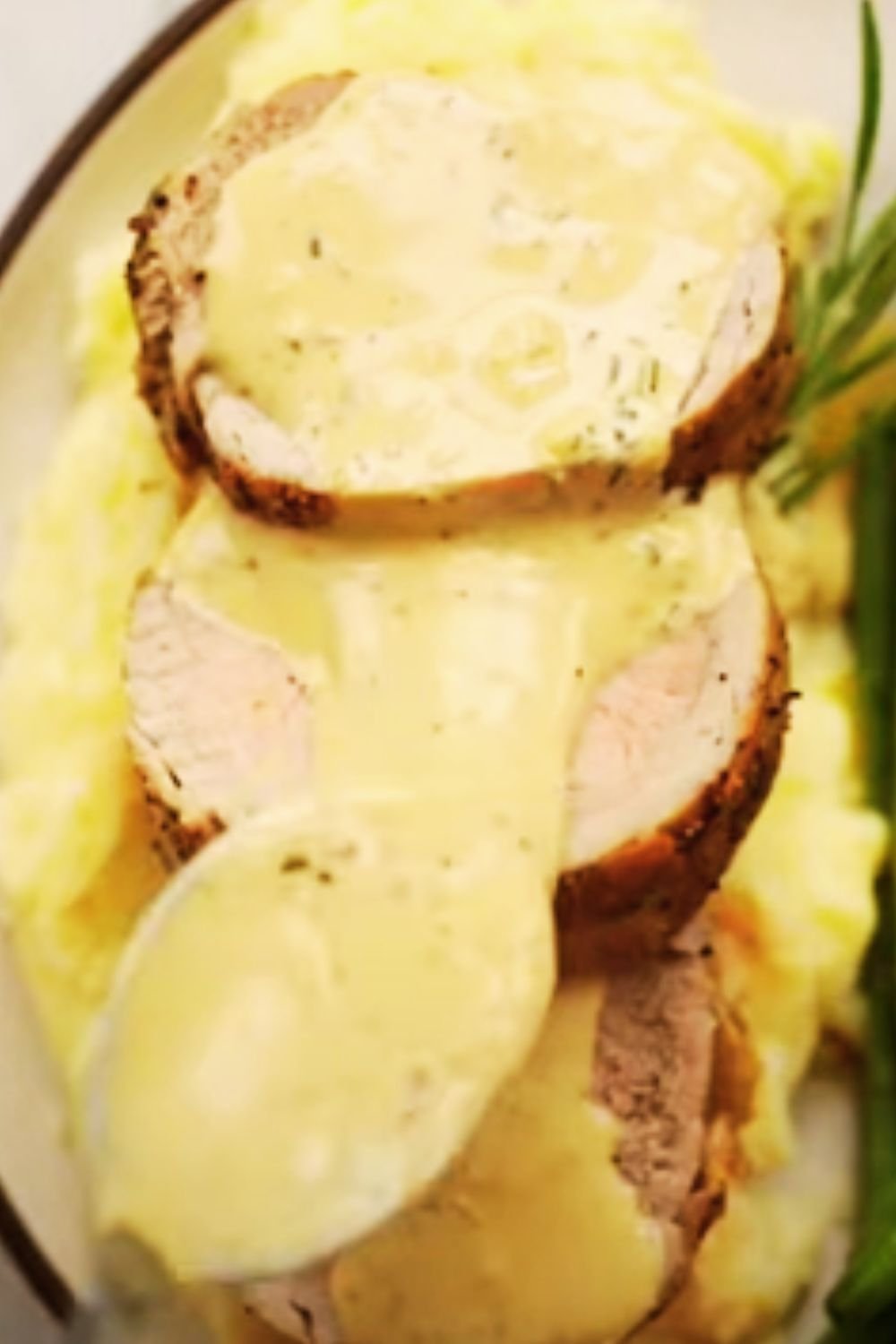When I first encountered Moambe Chicken during my culinary travels through Central Africa, I knew I had discovered something truly extraordinary. This isn’t just another chicken dish – it’s a celebration of flavor that tells the story of Congolese culture through every rich, aromatic bite. Today, I’m sharing everything I’ve learned about this magnificent dish that has become one of my absolute favorites to prepare and serve.
Moambe Chicken, known locally as Poulet Moambe, represents the heart and soul of Congolese cuisine. The dish centers around palm nut sauce – a creamy, orange-hued marvel that transforms ordinary chicken into something magical. What captivates me most about this recipe is how it balances complex flavors while remaining surprisingly approachable for home cooks.
Understanding Moambe: The Foundation of Flavor
Moambe : The term refers to both the palm nut sauce and dishes prepared with it. Derived from palm fruit, this sauce forms the backbone of countless Central African recipes.
Palm Nuts : The fruit of the African oil palm tree, these nuts produce a rich, flavorful oil and cream that’s essential to authentic Moambe preparation.
Poulet : Simply French for chicken, reflecting the colonial linguistic influence in Congolese cuisine.
Ngai Ngai : Traditional Congolese spinach often used in Moambe dishes, though collard greens make an excellent substitute.
The beauty of Moambe lies in its versatility. While chicken remains the most popular protein choice, I’ve successfully prepared variations with fish, beef, and even vegetarian versions using hearty vegetables. The sauce adapts beautifully to different ingredients while maintaining its distinctive character.

My Essential Ingredients Guide
Creating authentic Moambe Chicken requires understanding each component’s role in building layers of flavor. Through years of perfecting this recipe, I’ve identified the key ingredients that make the difference between good and extraordinary results.
Primary Ingredients
| Ingredient | Quantity | Purpose | Substitutions |
|---|---|---|---|
| Whole Chicken | 3-4 lbs, cut up | Main protein | Chicken thighs, drumsticks |
| Palm Nut Sauce | 2 cups | Base sauce | Canned palm cream |
| Onions | 2 large | Flavor foundation | Yellow or white onions |
| Garlic | 6-8 cloves | Aromatic base | Garlic powder (1 tbsp) |
| Ginger | 2-inch piece | Warmth and depth | Ground ginger (1 tsp) |
| Tomatoes | 3 medium | Acidity balance | Canned tomatoes (1 cup) |
| Palm Oil | 3 tablespoons | Authentic flavor | Vegetable oil |
Spices and Seasonings
| Spice | Amount | Flavor Profile | Notes |
|---|---|---|---|
| Bay Leaves | 3-4 leaves | Earthy, subtle | Remove before serving |
| Thyme | 2 teaspoons | Herbal brightness | Fresh preferred |
| Black Pepper | 1 teaspoon | Heat and pungency | Freshly ground |
| Salt | To taste | Flavor enhancement | Adjust gradually |
| Maggi Cubes | 2-3 cubes | Umami depth | Stock cubes work |
| Hot Peppers | 1-2 pieces | Heat level | Scotch bonnet preferred |
Vegetables and Greens
| Vegetable | Preparation | Cooking Time | Alternative |
|---|---|---|---|
| Spinach | Chopped, stems removed | 5-7 minutes | Collard greens |
| Okra | Sliced rounds | 10-12 minutes | Green beans |
| Eggplant | Cubed | 15-20 minutes | Zucchini |
| Sweet Potatoes | Chunked | 20-25 minutes | Regular potatoes |
My Step-by-Step Cooking Method
After preparing this dish countless times, I’ve refined my technique to ensure consistent, restaurant-quality results every time. The key lies in building flavors gradually and respecting the cooking process.
Preparation Phase
I always begin by organizing my workspace and preparing all ingredients beforehand. Moambe cooking moves quickly once you start, so having everything ready prevents any missteps.
Chicken Preparation:
- Clean and cut chicken into serving pieces
- Season generously with salt and pepper
- Allow to marinate for at least 30 minutes
- Pat dry before cooking to ensure proper browning
Sauce Base Preparation:
- Blend tomatoes, onions, garlic, and ginger into smooth paste
- Strain palm nut sauce if using canned version
- Chop all vegetables uniformly for even cooking
- Prepare spice mix in small bowl

Cooking Process
Step 1: Browning the Chicken Heat palm oil in large, heavy-bottomed pot over medium-high heat. I prefer using my Dutch oven for its excellent heat retention. Brown chicken pieces on all sides, working in batches to avoid overcrowding. This step creates the foundation flavors through the Maillard reaction, so don’t rush it.
Step 2: Building the Flavor Base Remove chicken and set aside. In the same pot, add the blended tomato mixture. Cook for 8-10 minutes, stirring frequently, until the mixture darkens and reduces significantly. This concentrates the flavors and removes raw taste.
Step 3: Incorporating the Palm Sauce Add palm nut sauce gradually, stirring constantly to prevent lumps. The sauce should be smooth and glossy. If it appears too thick, add small amounts of warm water or chicken stock.
Step 4: Seasoning and Simmering Return chicken to pot, add bay leaves, thyme, and Maggi cubes. Bring to gentle boil, then reduce heat to low simmer. Cover partially and cook for 30-40 minutes, stirring occasionally.
Step 5: Adding Vegetables Add vegetables in order of cooking time required – sweet potatoes first, then okra, finally greens. Each addition should be timed so everything finishes cooking simultaneously.
Step 6: Final Adjustments Taste and adjust seasoning. The sauce should coat the back of a spoon and have vibrant orange color. If too thin, simmer uncovered briefly to reduce.
Nutritional Benefits and Health Considerations
Understanding the nutritional aspects of Moambe Chicken helps me appreciate this dish beyond its incredible taste. Traditional African cuisine often provides excellent nutritional balance, and Moambe exemplifies this principle beautifully.
Nutritional Breakdown per Serving
| Nutrient | Amount | % Daily Value | Benefits |
|---|---|---|---|
| Calories | 485 | 24% | Sustained energy |
| Protein | 42g | 84% | Muscle maintenance |
| Fat | 28g | 43% | Essential fatty acids |
| Carbohydrates | 18g | 6% | Quick energy |
| Fiber | 4g | 16% | Digestive health |
| Iron | 3.2mg | 18% | Blood health |
| Vitamin A | 890 IU | 18% | Vision support |
| Vitamin C | 45mg | 75% | Immune function |
The palm nut sauce provides significant amounts of vitamin A and healthy fats, while the vegetables contribute essential vitamins and minerals. I particularly appreciate how this dish naturally incorporates multiple food groups in perfect harmony.

Cultural Significance and Regional Variations
My exploration of Moambe Chicken has taught me that food serves as a cultural bridge, connecting people across generations and geography. In Congolese culture, Moambe represents more than sustenance – it’s a symbol of hospitality, celebration, and community.
Regional Differences I’ve Discovered
Kinshasa Style:
- Heavier use of tomatoes
- Often includes fish alongside chicken
- Served with fufu or rice
Brazzaville Variation:
- More emphasis on leafy greens
- Sometimes includes peanut butter
- Typically spicier heat level
Equatorial Guinea Version:
- Addition of plantains
- Use of local herbs
- Coconut milk sometimes added
Cameroon Adaptation:
- Called “Sauce Graine”
- Often prepared with beef
- Different spice combinations
Each region adds its unique touch while maintaining the essential character that makes Moambe so special. I’ve learned to appreciate these variations and often incorporate elements from different traditions in my own preparations.
Serving Suggestions and Accompaniments
The way I serve Moambe Chicken has evolved through experience and cultural learning. Traditional accompaniments enhance the dish’s flavors while providing textural contrast that makes each meal memorable.
Traditional Starches
Fufu : The classic pairing, this starchy staple provides neutral base that absorbs the rich sauce beautifully.
Rice : Simple steamed rice works wonderfully, though I sometimes prepare coconut rice for extra richness.
Plantains : Fried or boiled plantains add natural sweetness that balances the sauce’s complexity.
Cassava : Boiled cassava offers authentic pairing with pleasant, mild flavor.
Modern Serving Ideas
I’ve successfully served Moambe Chicken with various contemporary sides that complement its African heritage while appealing to diverse palates:
- Quinoa pilaf with herbs
- Roasted sweet potato wedges
- Steamed jasmine rice
- Cauliflower rice for lighter option
- Crusty bread for sauce absorption
Beverage Pairings
Instead of alcoholic beverages, I recommend these refreshing options that cleanse the palate:
- Ginger beer with lime
- Hibiscus tea (cold or hot)
- Fresh coconut water
- Tropical fruit juices
- Sparkling water with mint
Storage and Reheating Tips
Through experience, I’ve learned that Moambe Chicken actually improves with time as flavors meld and develop. Proper storage ensures you can enjoy this dish for several days while maintaining its quality.
Refrigeration Guidelines
Store cooled Moambe in airtight containers for up to 4 days. The sauce may thicken considerably when cold – this is normal. When reheating, add small amounts of water or stock to restore proper consistency.
Freezing Instructions
Moambe freezes beautifully for up to 3 months. I portion it into family-sized containers for convenient future meals. Thaw overnight in refrigerator before reheating gently on stovetop.
Reheating Techniques
- Stovetop: Low heat, stirring frequently, adding liquid as needed
- Microwave: 50% power, stirring every 2 minutes
- Oven: 325°F covered, adding liquid as necessary
Common Mistakes and How I Avoid Them
Learning to prepare perfect Moambe Chicken involved making several mistakes that taught me valuable lessons. Sharing these helps others achieve better results from their first attempt.
Sauce-Related Issues
Problem: Lumpy or separated sauce Solution: Always add palm sauce gradually while stirring, maintain gentle heat
Problem: Sauce too thin or watery Solution: Simmer uncovered to reduce, or mix small amount of flour with cold water
Problem: Bitter taste in sauce Solution: Don’t burn the tomato base, cook over moderate heat with frequent stirring
Chicken Cooking Problems
Problem: Dry, overcooked chicken Solution: Don’t overcook during browning phase, simmer gently rather than boiling
Problem: Uneven seasoning Solution: Season chicken in advance, taste sauce frequently during cooking
Frequently Asked Questions
Q. Can I make Moambe Chicken without palm nut sauce? While palm nut sauce defines authentic Moambe, I’ve created acceptable versions using ground peanuts blended with tomatoes and spices. The flavor differs significantly, but the dish remains delicious.
Q. How spicy should traditional Moambe be? Traditional Moambe has moderate heat that builds gradually. I adjust spice levels based on my family’s preferences, starting conservatively and adding more as needed.
Q. What’s the best substitute for African spinach? Collard greens work excellently, providing similar texture and nutritional benefits. Swiss chard and kale also work well, though cooking times may vary slightly.
Q. Can I prepare Moambe in a slow cooker? Yes, though I recommend browning chicken and developing the sauce base on stovetop first. Transfer to slow cooker for 4-6 hours on low heat, adding vegetables during final hour.
Q. Why does my palm sauce look orange rather than red? Color varies depending on palm nut processing and tomato quantities. Both orange and reddish hues are authentic – focus on flavor development rather than specific color matching.
Q. How do I know when the chicken is properly cooked? Internal temperature should reach 165°F (74°C). The meat should be tender enough to easily separate from bones, and juices should run clear when pierced.
Q. Can I make this dish vegetarian? Absolutely! I substitute hearty vegetables like eggplant, sweet potatoes, and plantains for chicken. Add protein through beans or lentils if desired.
Q. What should I do if my sauce becomes too salty? Add diced potatoes or sweet potatoes to absorb excess salt. Alternatively, prepare additional unsalted sauce base and combine with the oversalted version.
Q. How long should I marinate the chicken? Minimum 30 minutes, though overnight marination in refrigerator produces superior flavor penetration. I often prepare chicken the evening before cooking.
Q. Can I use chicken breasts instead of whole chicken pieces? While possible, dark meat pieces like thighs and drumsticks provide better flavor and remain more tender during long cooking process. If using breasts, reduce cooking time accordingly.
Creating authentic Moambe Chicken connects me to a rich culinary tradition while providing my family with incredibly satisfying meals. This dish represents everything I love about cooking – it’s approachable yet sophisticated, deeply flavorful yet balanced, and brings people together around the table in celebration of good food and cultural appreciation.
The journey of mastering Moambe has taught me that great cooking isn’t just about following recipes – it’s about understanding ingredients, respecting traditions, and making dishes your own while honoring their origins. Every time I prepare this magnificent chicken dish, I’m reminded of the power of food to transcend boundaries and create lasting memories.


